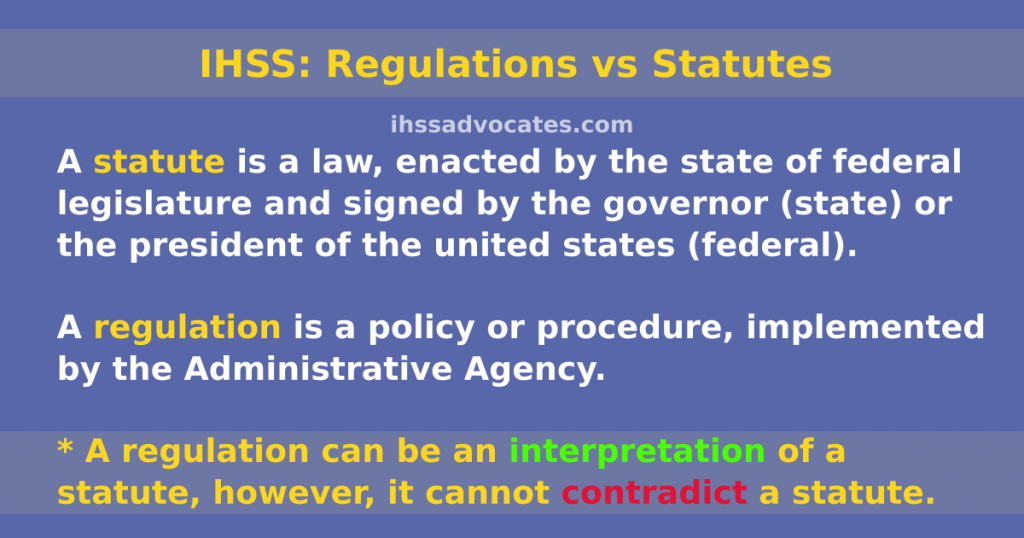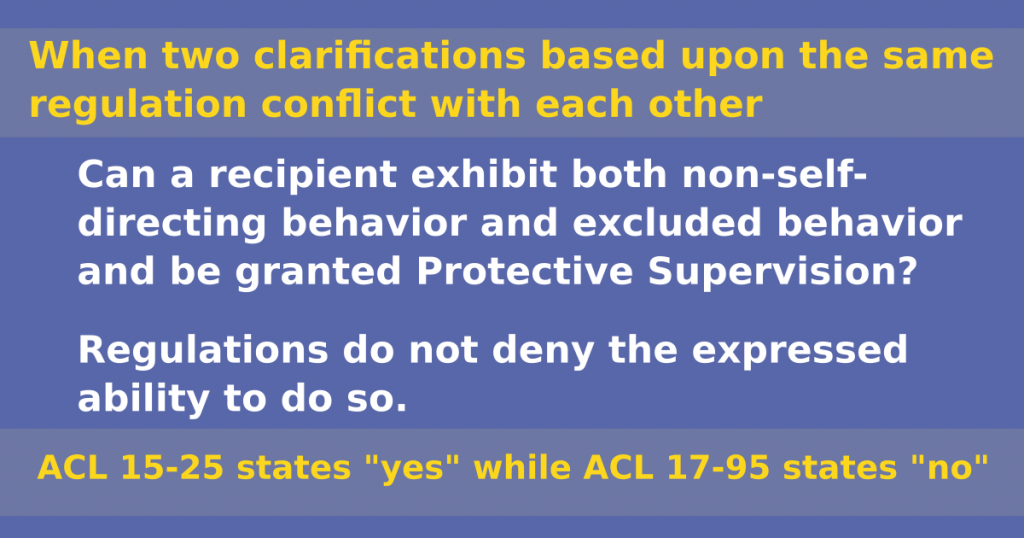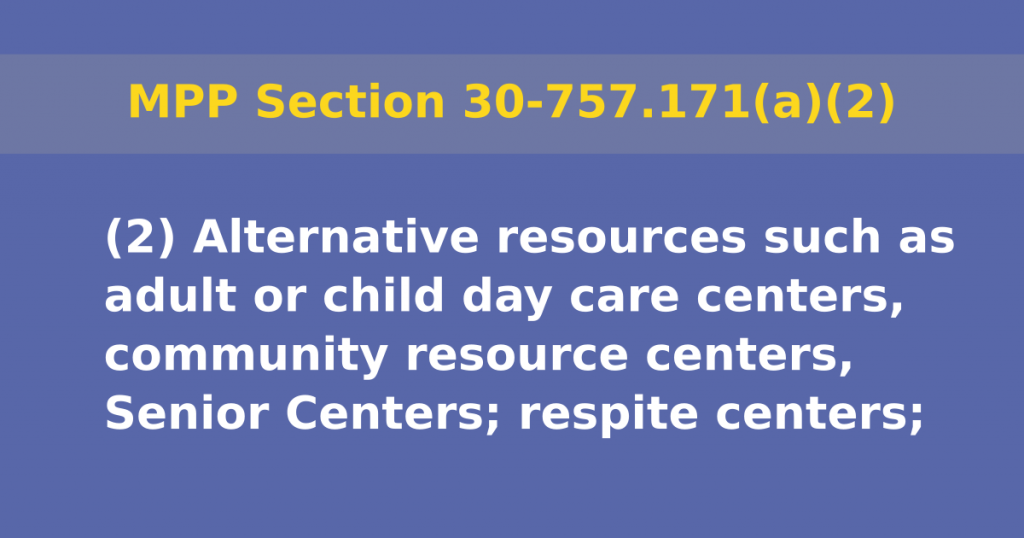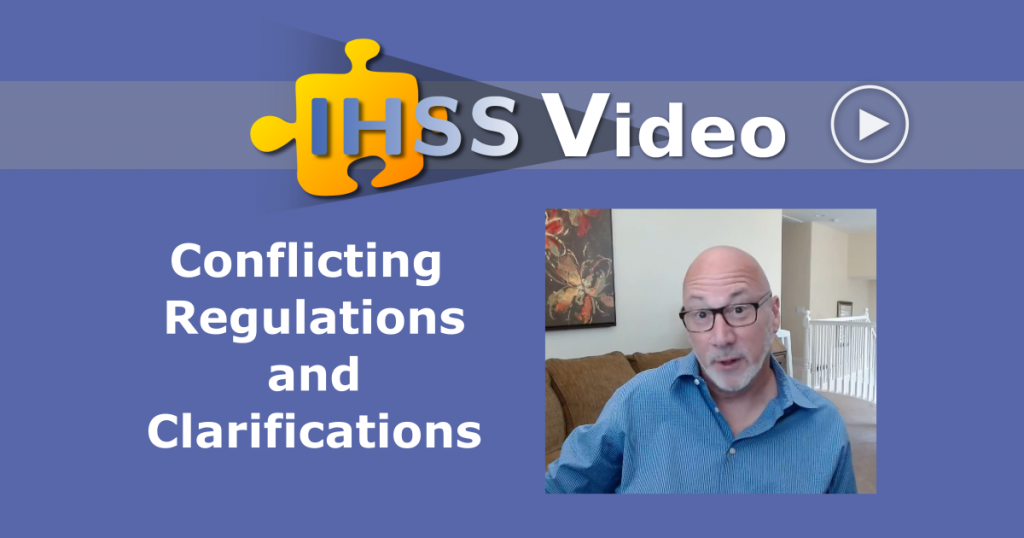Conflicting IHSS Regulations (MPPs) & Clarifications (ACLs) – Full Live Streamed Video
CDSS rules, regulations and clarifications are not always consistent with each other. In this IHSS video advocate, Larry Rosen uses three examples where the MPPs (CDSS’s Manual of Policies & Procedures) and the clarifications in the ACLs (All County Letters) conflict. Following Larry’s presentation is a short viewer questions and answers session that provides valuable information for anyone involved in the IHSS program in California.
Share Via:
Video Transcription & Notes:
Advocate Larry Rosen: Good Morning Everybody!
I am very grateful for the IHSS program that we have in the state of California.
Administered by the California Department of Social Services, it is arguably one of the best systems we have in our country today. But it is not perfect.
The function of our discussion today is to make you all aware that CDSS rules, regulations and clarifications are not always consistent with each other. Although many examples can be made, we will focus on three. But first, please understand that the courts have given Administrative Agencies great latitude in creating and enforcing their regulations:
The following three statements have been affirmed through either Federal or state superior court rulings.
- An administrative agency’s interpretations of the statutes and regulations governing the IHSS program are entitled to great weight and deference.
- The courts have held that an agency’s interpretation of its own regulations is the ” ‘ultimate criterion … which becomes of controlling weight unless it is plainly erroneous or inconsistent with the regulation.
- Similarly, our Supreme Court has held that ” … a court may not substitute its independent judgment for that of the administrative agency on the facts or on the policy considerations involved.
We allege that, at times, the agency’s interpretation of its own regulations has been plainly erroneous or inconsistent with the regulations.
We provide these three examples:
Example #1 – When a regulation conflicts with a statute
A statute is a law, enacted by the state of federal legislature and signed by the governor (state) or the president of the united states (federal).
A regulation is a policy or procedure implemented by the Administrative Agency.
A regulation can be an interpretation of a statute, however, it cannot contradict a statute.
The most obvious example to this concept is the recent elimination to the Protective Supervision pro-ration rules. Disability Rights of California was successful in establishing that the PS pro-ration rules violated the Americans with Disabilities act.

Example #2 – When two clarifications based upon the same regulation conflict with each other.
Can a recipient exhibit both non-self-directing behavior and excluded behavior and be granted Protective Supervision? Regulations do not deny the expressed ability to do so. ACL 15-25 states “yes”, but ACL 17-95 states “no”.

MPP § 30-757.172 establishes “Protective Supervision shall not be authorized:”
- (a) For friendly visiting or social activities.
- (b) When the need is caused by a medical condition and the form of the supervision required is medical.
- (c) In anticipation of a medical emergency.
- (d) To prevent or control ant i-social or aggressive recipient behavior.
- (e) To guard against deliberate self-destructive behavior, such as suicide, or when an individual knowingly intends to harm himself/herself.

This regulation is an administrative agency’s (CDSS) policy and procedure; however, as previously stated, it does not provide expressed authority to deny Protective Supervision when non-excludable evidence of non-self-direction is also present.
ACL 15-25 was initiated by CDSS on March 19, 2015. It contains the following citations that clearly demonstrates that it is permissible for a Protective Supervision recipient to exhibit both excluded and non-excludable examples of non-self- directing behavior.
ACL 15-25 Page 2 & 3 Section: “Mentally Impaired/Mentally Ill and Non-self-Directing”
“In addition to all other relevant eligibility criteria, a person must be both mentally impaired or mentally ill and non-self-directing to be eligible for Protective Supervision. It is not sufficient for someone to just be mentally impaired/mentally ill, there must also be evidence that he/she is non-self-directing. This policy is based on the court rulings in the Marshall v. McMahon, {1993) 17 Cal. App. 4th 1841, and Calderon v. Anderson, (1996) 45 Cal. App. 4th 607, cases, and will also be reflected in forthcoming amendments to the Protective Supervision regulations found at MPP § 30-757.17.”
ACL 15-25 Page 3 Section: “Excluded Needs and Behaviors under MPP 30-757.172”
“The exclusions listed under MPP 30-757.172 are applicable if a recipient is otherwise eligible for Protective Supervision in that s/he has the requisite mental impairment/mental illness, is nonself-directing, and would likely engage in potentially dangerous behaviors.”
Larry: Expanding on item listed above:
ACL 15-25 Page 4 Middle of page after 2nd bullet point
“If a recipient only displays needs or behaviors excluded under MPP 30-757.172, they are not eligible for Protective Supervision. If a recipient displays excluded behaviors(s) based upon MPP 30-757.172, they may still be eligible for Protective Supervision for the non-excluded behaviors.”
Larry: In contrast, ACL 17-95, initiated by CDSS on September 12, 2017, provides an advisement that contradicts the advisement noted in ACL 15-25. Whereas ACL 15-25 clearly demonstrates that it is permissible for a Protective Supervision recipient to exhibit both excluded and non-excludable examples of non-self-directing behavior, the semantics of the advisement in ACL 17-95 suggests that any example of excludable behavior disqualifies any potential Protective Supervision applicant, regardless of the presence of any quantity of non-excludable examples of non-self-directing behavior.
ACL 17-95 Page 6 & 7 Section: “Anti-Social and Aggressive Behaviors and PS-Eligibility”
“Assessing PS-eligibility, due to a recipient’s (minor or adult) combative behavior, shall be evaluated based upon the willfulness of that behavior. As with all services, the recipient’s age and specific behavior shall be considered.”
“When assessing for PS-eligibility, a recipient must have a mental impairment/illness and determined to be non-self-directing, due to the mental impairment/illness. The recipient would be considered non-self-directing if he/she is unable to assess danger and the risk of self-harm. A recipient who meets these criteria and displays self-destructive behaviors, such as headbanging, as a manifestation of the mental impairment/illness, may be eligible for PS. However, a recipient who has a mental impairment/illness and is determined to be non-self-directing, due to the mental impairment/illness, but exhibits anti-social or aggressive behavior (e.g. pulling hair, scratching, hitting) directed to harm another individual, would be ineligible for PS. [MPP Section 30-757.172 (d)].”
“Additionally, a recipient who displays intentional self-destructive behavior, with knowledge that the activity may cause self-harm, would not be PS-eligible. [MPP Section 30-757.172(e).] This type of behavior may include tantrums or head-banging as a way to achieve a desired result. In this case, the recipient would be considered self-directing, as there is knowledge that the activity may cause self-harm; therefore, he/she would be ineligible for PS.”
Larry: We believe that the advisement in ACL 17-95 run contrary to CDSS regulations for several reasons.
How ACL 17-95 is contrary to CDSS regulations
- The advisements found in ACL 15-25 do not automatically result in Protective Supervision approval. Any concerns about the remaining evidence of non-self-direction would be examined in the further steps of the process. In contrast, the advisement’s found in ACL 17-95 DO result in instant termination, even in situations where the excluded behavior is a tiny fraction of the evidence of non-self-direction.
- The advisement found in ACL 17-95 effectively creates an evidentiary standard greater than that of a “shadow of a doubt” whereas CDSS regulations indicate the intended standard of evidence is “preponderance of evidence”.
- The advisement found in ACL 17-95 effectively blocks a minor’s consideration to the principles agreed to in the Garrett v Anderson court stipulated agreement. Many of these principles were also adopted into CDSS regulation.
ACL 15-25 vs ACL 17-95
The advisements discussed in ACL 15-25 are very reasonable and do not necessarily provide Protective Supervision to an otherwise undeserving recipient. In contrast, the advisements in ACL 17-95 do potentially deny Protective Supervision to otherwise non-self-directing individuals, as described in Calderon v Anderson.
We have seen multiple cases with multiple pages pf examples of “evidence of non-self-direction”, taken from relevant documents, routinely denied solely due to the presence of an unspecified quantity of excluded behaviors.
Example #3 – The semantics of clarifications are not always the same as the regulation.
Here is a clarification found in All County Letter 17-95 regarding alternate resources:
ACL 17-95 page 4 Section: “Alternative Resources”
Alternative resources are considered to be supportive services, which may be available from other agencies or programs to meet the needs of the recipient, as assessed. (MPP Section 30-763.61.) The County shall arrange for the delivery of such alternative resources as necessary, in lieu of IHSS program-funded services when they are available and result in no cost to the IHSS program or the recipient, except as provided in Section 30-763.613. (MPP Section 30-763.611.) Examples of alternative resources include, but are not limited to, adult or child day care centers, schools, community resource centers, Senior Centers, or respite centers. [MPP Section 30-757.171(a)(2).]
Larry: However, when you look at MPP section 30-757.171(a)(2), you will discover that school was not originally listed as an example of an alternate resource.

Larry: As a result of this clarification, I am sure many of you have seen reductions in your IHSS hours due to personal care services being provided at school. The regulation does not give a social worker an expressed ability to make this deduction. It is the interpretation of the regulation that allows this to happen.
In closing, this advocate is aware of several inconsistencies within IHSS policy and procedure and is working with the Law Office of James Diskint, through submission of writ requests in superior court, to get objective clarity to these inconsistencies.
I was advised by my mentor, Charles Wolfinger, many years ago that CDSS has the ability to change departmental policy through the use of modified regulatory interpretation. With that being said, please understand that there is value in pursuing the overturning of an IHSS Protective Supervision denial with the assistance of an expert who has encountered similar issues on countless occasions. There is definitely an arbitrary nature to this process.
Download All County Letters & MPPs Referenced
- ACL 15-25 – Protective Supervision Clarifications
- ACL 17-95 – Clarification of Protective Supervision Proration, Environmental Modifications, Fall Risk, and Combative Behavior Issues
- MPPs – CDSS’s Manual of Policies and Procedures
Denied Protective Supervision?
Click the button below to get a free advocate evaluation of your child’s IHSS Protective Supervision case.
Click here to see more IHSS videos by IHSSadvocates

